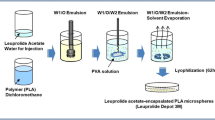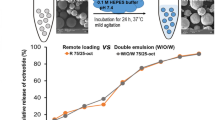Abstract
The purpose of the present study was to characterize the in vivo release kinetics of octreotide acetate from microsphere formulations designed to minimize peptide acylation and improve drug stability. Microspheres were prepared by a conventional oil/wate (o/w) method or an experimental oil/oil (o/o) dispersion technique. The dosage forms were administered subcutaneously to a rat animal model, and serum samples were analyzed by radioimmunoassay over a 2-month period. An averaged kinetic profile from each treatment group, as a result, was treated with fractional differential equations. The results indicated that poly(l-lactide) microspheres prepared by the o/o dispersion technique provided lower area under the curve (AUC) values during the initial diffusion-controlled release phase, 7.79 ng×d/mL, versus 75.8 ng/sxd/mL for the o/w batch. During the subsequent erosion-controlled release phase, on the other hand, the o/o technique yielded higher AUC values, 123 ng×d/mL, versus 42.2 ng×d/mL for the o/w batch. The differences observed between the 2 techniques were attributed to the site of drug incorporation during the manufacturing process, given that microspheres contain both porous hydrophilic channels and dense hydrophobic matrix regions. An o/o dispersion technique was therefore expected to produce microspheres with lower incorporation in the aqueous channels, which are responsible for diffusion-mediated drug release.
Similar content being viewed by others
References
Murty SB, Goodman J, Thanoo BC, DeLuca PP. Identification of chemically modified peptide from poly(D,L-lactide-co-glycolide) microspheres under in vitro release conditions.AAPS PharmSciTech. 2003;4:E50.
De Weck AL. Immunological effects of aspirin anhydride, a contaminant of commercial acetylsalicylic acid preparations.Int Arch Allergy Appl Immunol. 1971;41:393–418.
Jeyanthi R, Thanoo BC, Mehta RC, DeLuca PP. Effect of solvent removal technique on the matrix characteristics of polylactide/glycolide microspheres for peptide delivery.J Control Release. 1996;38:235–244.
Jeyanthi R, Mehta RC, Thanoo BC, DeLuca PP. Effect of processing parameters on the properties of peptide-containing PLGA microspheres.J Microencapsul. 1997;14:163–174.
Kostanski JW, Thanoo BC, DeLuca PP. Preparation, characterization, and in vitro evaluation of 1- and 4-month controlled release orntide PLA and PLGA microspheres.Pharm Dev Technol. 2000;5:585–596.
Herrman J, Bodmeier R. Biodegradable, somatostatin acetate containing microspheres prepared by various aqueous and non-aqueous solvent evaporation methods.Eur J Pharm Biopharm. 1998;45:75–82.
Lai MC, Hageman MJ, Schowen RL, Borchardt RT, Topp EM. Chemical stability of peptides in polymers. 1. Effect of water on peptide deamidation in poly(vinyl alcohol) and poly(vinyl pyrrolidone) matrixes.J Pharm Sci. 1999;88:1073–1080.
Lai MC, Hageman MJ, Schowen RL, Borchardt RT, Laird BB, Topp EM. Chemical stability of peptides in polymers. 2. Discriminating between solvent and plasticizing effects of water on peptide deamidation in poly(vinylpyrrolidone).J Pharm Sci. 1999;88:1081–1089.
Hausberger AG, DeLuca PP. Characterization of biodegradable poly(D,L-lactide-co-glycolide) polymers and microspheres.J Pharm Biomed Anal. 1995;13:747–760.
Comets E, Mentre F, Kawai R, Nimmerfall F, Marbach P, Vonderscher J. Modeling the kinetics of release of octreotide from long-acting formulations injected intramuscularly in rabbits.J Pharm Sci. 2000;89:1123–1133.
Murata K, Noda K, Kohno K, Samejima M. Pharmacokinetic analysis of concentration data of drugs with irregular absorption profiles using multi-fraction absorption models.J Pharm Sci. 1987;76:109–113.
Hwang SS, Bayne W, Theeuwes F.In vivo evaluation of controlled-release products.J Pharm Sci. 1993;82:1145–1150.
Lemaire M, Azria M, Dannecker R, Marbach P, Schweitzer A, Maurer G. Disposition of sandostatin, a new synthetic somatostatin analogue, in rats.Drug Metab Dispos. 1989;17:699–703.
Mason-Garcia M, Vaccarella M, Horvath J, et al. Radioimmunoassay for octapeptide analogs of somatostatin: measurement of serum levels after administration of long-acting microcapsule formulations.Proc Natl Acad Sci U S A. 1988;85:5688–5692.
Author information
Authors and Affiliations
Corresponding author
Rights and permissions
About this article
Cite this article
Murty, S.B., Wei, Q., Thanoo, B.C. et al. In vivo release kinetics of octreotide acetate from experimental polymeric microsphere formulations using oil/water and oil/oil processes. AAPS PharmSciTech 5, 49 (2004). https://doi.org/10.1208/pt050349
Received:
Accepted:
DOI: https://doi.org/10.1208/pt050349




